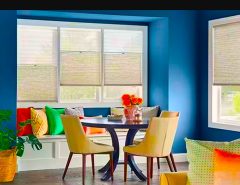Custom windows are a great way to enhance the look and feel of your home, but they can also provide several benefits beyond aesthetics. One of the most significant advantages of custom windows is their potential to improve energy efficiency, which can help you save money on heating and cooling costs while reducing your carbon footprint. Here are some energy-efficient features to consider when customizing your windows.
Low-E Glass
Low-emissivity (Low-E) glass is a type of glass that has a thin, transparent coating that reflects heat. This coating helps to prevent heat from escaping your home during the winter and entering your home during the summer, which can help to reduce your energy bills. Additionally, Low-E glass can help to reduce the fading of furniture, flooring, and other items in your home by blocking harmful UV rays.
Gas Fills
Another energy-efficient feature to consider when customizing your windows is gas fills. Gas fills are gases, such as argon or krypton, that are inserted between the panes of glass in double or triple-pane windows. These gases are denser than air, which helps to reduce heat transfer through the window. This can lead to improved insulation, which can help to keep your home more comfortable while reducing your energy bills.
Warm-Edge Spacers
Warm-edge spacers are another energy-efficient feature to consider when customizing your windows. Warm-edge spacers are narrow strips of material that separate the panes of glass in double or triple-pane windows. These spacers help to reduce heat transfer through the window by creating a thermal barrier between the panes. This can help to improve insulation and reduce the risk of condensation, which can lead to mold and other problems.
Multiple Panes
Single-pane windows are the least energy-efficient type of window, as they provide little insulation and allow heat to escape easily. Double and triple-pane windows, on the other hand, provide multiple layers of insulation, which can help to keep your home more comfortable while reducing your energy bills. Additionally, the air or gas between the panes can help to reduce outside noise, which can improve your overall comfort.
Frame Materials
The frame material of your windows can also impact their energy efficiency. Common frame materials include wood, vinyl, aluminum, and fiberglass. Each material has its own advantages and disadvantages when it comes to energy efficiency. For example, wood frames provide good insulation, but require regular maintenance to prevent rot and decay. Vinyl frames are low-maintenance and provide good insulation, but can warp over time. Aluminum frames are strong and durable, but provide poor insulation. Fiberglass frames are energy-efficient and low-maintenance, but can be more expensive than other materials.
Installation
Proper installation is crucial to the energy efficiency of your custom windows. Even the most energy-efficient windows can lose their effectiveness if they are installed improperly. Make sure to hire a reputable installer who has experience installing custom windows. Additionally, be sure to ask about the installation process and what measures will be taken to ensure that your windows are properly sealed and insulated.
In conclusion, when customizing your windows, there are many energy-efficient features to consider that can help to improve your home’s comfort and reduce your energy bills. Low-E glass, gas fills, warm-edge spacers, multiple panes, frame materials, and proper installation are all factors to consider when choosing the right windows for your home. By working with a reputable window company, you can design and install custom windows that not only look great but also provide significant energy savings and environmental benefits.




